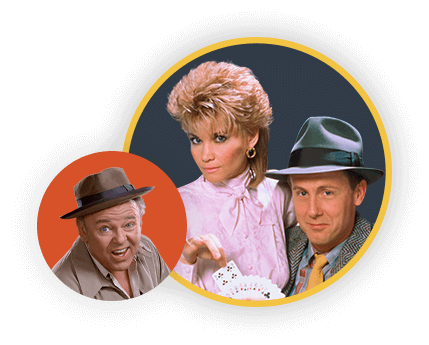9 British TV shows that made it to America in the 1960s

The British Invasion went beyond the Beatles and Herman's Hermits, beyond music in fact. Perhaps more so than any other time, the 1960s saw Americans devouring British pop culture, from Mary Quant's miniskirts to Mary Poppins. James Bond was the king of the big screen and MG advertised its cars in magazines.
Naturally, this carried over to television. The spy craze led to an influx of British television productions on American networks. Here were shows produced in the U.K. on the Big Three networks in primetime. Often, the imports were plugged in as summer replacements. Some of these shows were so massive — or used American actors — it's easy to forget they were English.
Here are nine British shows with their American network and year of U.S. premiere. They were all action series. No comedies made it over the pond to network primetime, because some things just don't translate culturally, despite the fad. In fact, the only thing that didn't seem to click with 1960s Americans (at first) was Monty Python. The comedy troupe's Flying Circus premiered on the BBC in 1969, but would not turn up on PBS for half a decade.

The Avengers
ABC, 1966
Though it now struggles against Marvel blockbusters in Google searches, the Avengers were once popular enough to merit its own (and admittedly regretful) cinematic remake in 1998. The sexy, tough Emma Peel and the posh John Steed made for a perfect pair, first appearing together in the fourth season in 1965. ABC paid a handsome $2 million for 26 episodes in 1966, affording the series high production values.
Image: ABC / ITV

The Baron
ABC, 1966
Novelist John Creasey cranked out hundreds of books, page-turning adventures with characters like Gideon of Scotland Yard and the Baron. The latter earned a television adaptation with American actor Steve Forrest in the title role as John Mannering, an antiques dealer and undercover agent. Filmed in the U.K., the dialogue was overdubbed to change terms like "petrol" to "gas," etc. Like any good agent, Mannering had an enviable car, a Jensen CV-8 Mk II.
Image: Wikipedia

The Champions
NBC, 1968
Why did the title have to cover up Alexandra Bastedo's face in the opening? (Not to mention the other two.) The stunning blond would at least get to show her features on the cover of a Smiths album in 1988. Bastedo, Stuart Damon and William Gaunt starred as a trio of agents for Nemesis, a United Nations intelligence agency based in Geneva. The three trotted across the globe, taking down Nazis and madmen.
Image: Wikipedia

Journey to the Unknown
ABC, 1968
Iconic horror house Hammer Film Productions Ltd. turned out this deliciously dark anthology series that featured American stars such as George Maharis and Patty Duke. In the episode "The Last Visitor," Duke plays a woman stalked at a resort. It fits nicely alongside series like Thriller and Night Gallery.
Image: Hammer Film / 20th Century Fox Television

Man in a Suitcase
ABC, 1968
When Patrick McGoohan jumped from Danger Man (a.k.a. Secret Agent) to The Prisoner, much of the Danger Man crew shifted to this espionage thriller. Like The Baron, Man in a Suitcase featured an American actor in the lead. Unlike the jet-setting spies of the era, this show's hero, McGill, was pushed into the shadows, a disgraced CIA agent forced to resign and take work where he could find it. With its gray morality and increased violence, this Man was ahead of his time.
Image: Wikipedia

The Prisoner
CBS, 1968
The brilliant blend of spy thriller and science-fiction became a cultural touchstone despite lasting a mere 17 episodes. The premise — an agent being held on a mysterious resort island — has been repeated, parodied and referenced countless times over the last half-century. Some fans theorized that McGoohan's character, No. 6, was in fact his earlier character John Drake of Secret Agent/Danger Man. The actor denied it, yet the debate rages on. It is fascinating to view The Prisoner as a Secret Agent sequel.
Image: CBS / ITV

The Saint
NBC, 1967
Before Roger Moore slurped his shaken martinis as James Bond, he was another dapper secret agent, Simon Templar. The adventures were based on the Templar novels originally written by Leslie Charteris in the 1920s and '30s. In the early black and white episodes, Moore breaks the fourth wall and addresses the audience, though the gimmick was given up when the series went color. In 1997, Val Kilmer starred in a Hollywood remake.

Secret Agent
CBS, 1965
Sing along now: "Secret… AY-gent Man! Secret… AY-gent Man!" The twangy Johnny Rivers theme song helped popularize this American retitling of Danger Man, and the tune was later covered by Devo and stuck in the first Austin Powers movie. But this was far more than a catchy song, with McGoohan's John Drake taking on realistic Cold War threats.
Image: CBS / ITV

Thunderbirds
Syndicated, 1968
Puppet action! Just how popular were these marionettes? In 2015, Amazon Prime launched a new Thunderbirds Are Go series, though sadly it was computer animated, not controlled by strings. The inventive creation of Gerry and Sylvia Anderson was the Voltron for 1960s kids, mixing the family dynamics of Lost in Space with the low-budget thrills of playing make-believe with dolls. There was some serious special effects talent at work here. Effects director Derek Meddings went on to work on James Bond and Superman films. Miniature models beat CGI every time.
Image: ITC Entertainment




